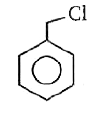Alkyl halide undergoes nucleophilic substitution reaction in which halogen atom is replaced by other atom.
RX+Nu:−→Nu−R+X−
Which of the following is least reactive towards SN2 mechanism?
(CH3)3CCH2Br
(CH3)2CHCH2Br
CH3CH2Br
(CH3)2CHBr
The correct Answer is:A
To determine which alkyl halide is least reactive towards the SN2 mechanism, we need to analyze the structure of the given alkyl halides and their degree of substitution.
1. Understand the SN2 Mechanism:
- The SN2 (Substitution Nucleophilic Bimolecular) mechanism involves a nucleophile attacking the carbon atom that is bonded to the leaving group (halogen) from the opposite side, leading to a simultaneous bond formation and bond breaking. This results in an inversion of configuration at the carbon center.
2. Identify the Degree of Alkyl Halides:
- The reactivity of alkyl halides in SN2 reactions decreases with increasing steric hindrance. The order of reactivity is:
- 1° (primary) > 2° (secondary) > 3° (tertiary).
3. Analyze the Given Options:
- Let's denote the options:
- Option 1: CH3CH(CH3)2Br (This is a 2° alkyl halide)
- Option 2: C(CH3)3Br (This is a 3° alkyl halide)
- Option 3: CH3CH2CH2Br (This is a 1° alkyl halide)
4. Determine the Least Reactive Alkyl Halide:
- Since 3° alkyl halides are the least reactive in SN2 reactions due to steric hindrance, option 2 (C(CH3)3Br) is the least reactive towards the SN2 mechanism.
5. Conclusion:
- The alkyl halide that is least reactive towards the SN2 mechanism is option 2: C(CH3)3Br.
- The SN2 (Substitution Nucleophilic Bimolecular) mechanism involves a nucleophile attacking the carbon atom that is bonded to the leaving group (halogen) from the opposite side, leading to a simultaneous bond formation and bond breaking. This results in an inversion of configuration at the carbon center.
- The reactivity of alkyl halides in SN2 reactions decreases with increasing steric hindrance. The order of reactivity is:
- 1° (primary) > 2° (secondary) > 3° (tertiary).
- Let's denote the options:
- Option 1: CH3CH(CH3)2Br (This is a 2° alkyl halide)
- Option 2: C(CH3)3Br (This is a 3° alkyl halide)
- Option 3: CH3CH2CH2Br (This is a 1° alkyl halide)
- Since 3° alkyl halides are the least reactive in SN2 reactions due to steric hindrance, option 2 (C(CH3)3Br) is the least reactive towards the SN2 mechanism.
- The alkyl halide that is least reactive towards the SN2 mechanism is option 2: C(CH3)3Br.
Topper's Solved these Questions
Similar Questions
Knowledge Check
- Question 1 - Select One
Which of the following is most reactive towardSN2 reaction ?
A B
B C
C D
D
- Question 2 - Select One
Which of the following is most reactive towardSN2 reaction ?
ACH2=CH−CH2−ClBPh−CH2−ClC DPh−C∣∣O−CH2−Cl
DPh−C∣∣O−CH2−Cl - Question 3 - Select One
Aryl halides are less reactive towards nucleophilic substitution reaction as compared to alkyl halides due to
Aformation of a less stable carbonium ion in aryl halidesBresonance stabilisation in ary halidesCpresence of double bonds in alkyl halidesDinductive effect in aryl halides.
Which of the following is least reactive towards nucleo- philic substitution?
View SolutionWhich degree of alkyl halide is Most reactive towards E2 mechanism:
View SolutionWhich of the following alkyl halide will undergo SN1 reaction is
View SolutionWhich of the following is most reactive towards nucleophilic substritution reaction?
View SolutionWhich of the following is the most reactive towards nucleophilic substitution reaction?
View Solution
